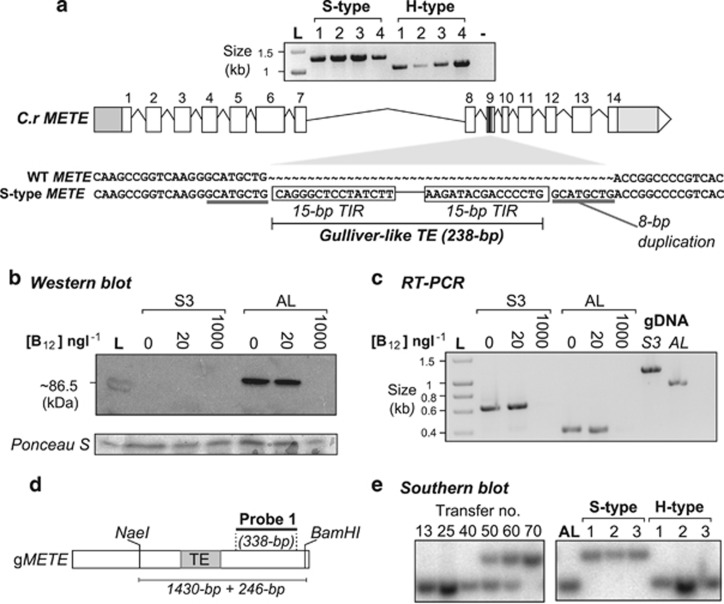Figure 2.
Identification of a Gulliver-related transposable element (GR-TE) in the METE gene of E8+ S-type cells. (a) PCR on genomic DNA of four independent S- and H-type clones using primer pair F2b/R3b (amplifying a 1-kb region between 4.4 kb and 5.4 kb from the start codon) reveals an unexpectedly large product for S-type clones (expected product size for wild-type (WT) METE: 1003 bp). A BLAST search using the sequence from the S-type product revealed a strong (E-value: 8e−67) hit for C. reinhardtii METE (Supplementary Figure S2a). Another hit (E-value: 2e−87) 238 bp in size was identified as a class-II GR-TE (Kim et al., 2005, 2006; Supplementary Figure S2b). The schematic diagram shows an alignment between C. reinhardtii WT METE in this region compared with the ‘S-type' product sequence. A target-site duplication of METE (grey underline) flanks a 15-bp terminal-inverted-repeat (boxed). (b) Western blotting analysis on total protein of E8+ and AL cells using a polyclonal antibody against C. reinhardtii METE (∼86.5 kDa; Schneider et al., 2008; L: Ladder). To verify adequate transfer and equal loading, the membrane was stained in Ponceau stain (Ponceau S) (c) Reverse transcriptase-PCR reveals that METE is expressed and regulated by B12 in E8+. Expected products using primers Transcript_F1/R1: AL gDNA: 902 bp (+246 bp with TE+8-bp METE repeat, that is, 1148 bp), cDNA: 371 bp (+246 bp, that is, 617 bp). (d) Schematic diagram of probe used for Southern blotting. (e) Southern blotting analysis using the METE probe (probe 1) on genomic samples for stock-points and independent S- and H-type clones.

